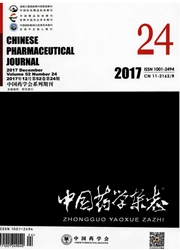

 中文摘要:
中文摘要:
目的 探讨芳香苷类化合物xylocontroside D对Aβ1-42诱导的原代培养大鼠大脑皮质神经元退行性损伤的氧化应激损伤与神经炎症损伤环节是否具有抑制作用。方法 用Aβ1-42诱导原代培养的大鼠大脑皮质神经元启动死亡过程,通过四甲基偶氮唑蓝法检测细胞存活率;用荧光探针CM3-H2DCFDA标记神经元,然后用流式细胞术检测细胞浆中内源性活性氧化物的含量,并对活性氧化物攻击核酸的代谢产物8-羟基脱氧鸟苷进行分析。同时分析Aβ1-42诱导小胶质细胞的活化,并用ELISA法检测细胞培养上清液中的炎性因子。结果 Aβ1-42 (终浓度25.0 μmol·L^-1)可诱导神经元的死亡;芳苷类化合物xylocontroside D在终浓度为1.0、10.0 μmol·L^-1的条件下,对Aβ1-42诱导的神经元死亡具有显著抑制作用(P<0.01或P<0.001),且其作用与药物剂量呈依赖关系(相关系数r=0.817),在终浓度0.1 μmol·L^-1时统计学无显著性;Aβ1-42在低于诱发神经元死亡的浓度(终浓度10.0 μmol·L^-1)情况下,可诱导神经元内活性氧化物和8-羟基脱氧鸟苷的生成量增加,终浓度10 μmol·L^-1的芳苷类化合物xylocontroside D对二者的产生具有显著的抑制作用(P<0.05或P<0.01);Aβ1-42(终浓度25.0 μmol·L^-1)可诱导小胶质细胞的活化,并促进小胶质细胞合成释放炎性因子环氧化酶-1、环氧化酶-2、白介素-1β和肿瘤坏死因子α增多,终浓度10 μmol·L^-1的芳苷类化合物xylocontroside D对炎性因子的合成与释放显示出明显的抑制作用(P<0.05或P<0.01)。结论 芳香苷类化合物xylocontroside D可以抑制Aβ1-42诱导的大鼠大脑皮质神经元退行性损伤的氧化应激损伤与神经炎症损伤环节。
 英文摘要:
英文摘要:
OBJECTIVE To investigate the inhibitory effects of phenolic glycoside compound xylocontroside D on neurotoxicity of primary cultured cortical neurons induced by Aβ1-42. METHODS The primary cortical neurons and microglia cells derived from rat cerebral tissues were used and neurotoxicity were induced by Aβ1-42. Then the thiazolyl blue tetrazolium bromide test(MTT) was applied for detecting cell survivability; cells were incubated with CH3-H2DCF-DA for evaluating cellular endogenous reactive oxygen species(ROS) level by flow cytometry;fluorescent staining of 8-hydroxy-2-deoxyguanosine(8-OH-DG) was applied for identifying the metabolites of ROS based DNA damage; fluorescent imaging was applied for illustrating the activation of microglia cells and the enzyme-linked immunosorbent assay(ELISA) was applied for analysis of pro-inflammatory cytokines, cyclooxygenase-1(COX-1), cyclooxygenase-2(COX-2), interleukin-1beta(IL-1β) and tumor necrosis factor alpha(TNF-α). RESULTS Xylocontroside D showed significant inhibitory effects on Aβ1-42 induced neurotoxicity, including cell death, cellular endogenous ROS levels and DNA damage caused by ROS reaction. Moreover, this compound could also prevent the activation of microglia, decrease the production or secretion of pro-inflammatory cytokines that produced by activated microglia, such as COX-1, COX-2, IL-1β and TNF-α. CONCLUSION Our RESULTS indicated that xylocontroside D was able to inhibit the oxidative stress injury and neuroinflammation of primary cultured cortical neurons induced by Aβ1-42.
 同期刊论文项目
同期刊论文项目
 同项目期刊论文
同项目期刊论文
 期刊信息
期刊信息
